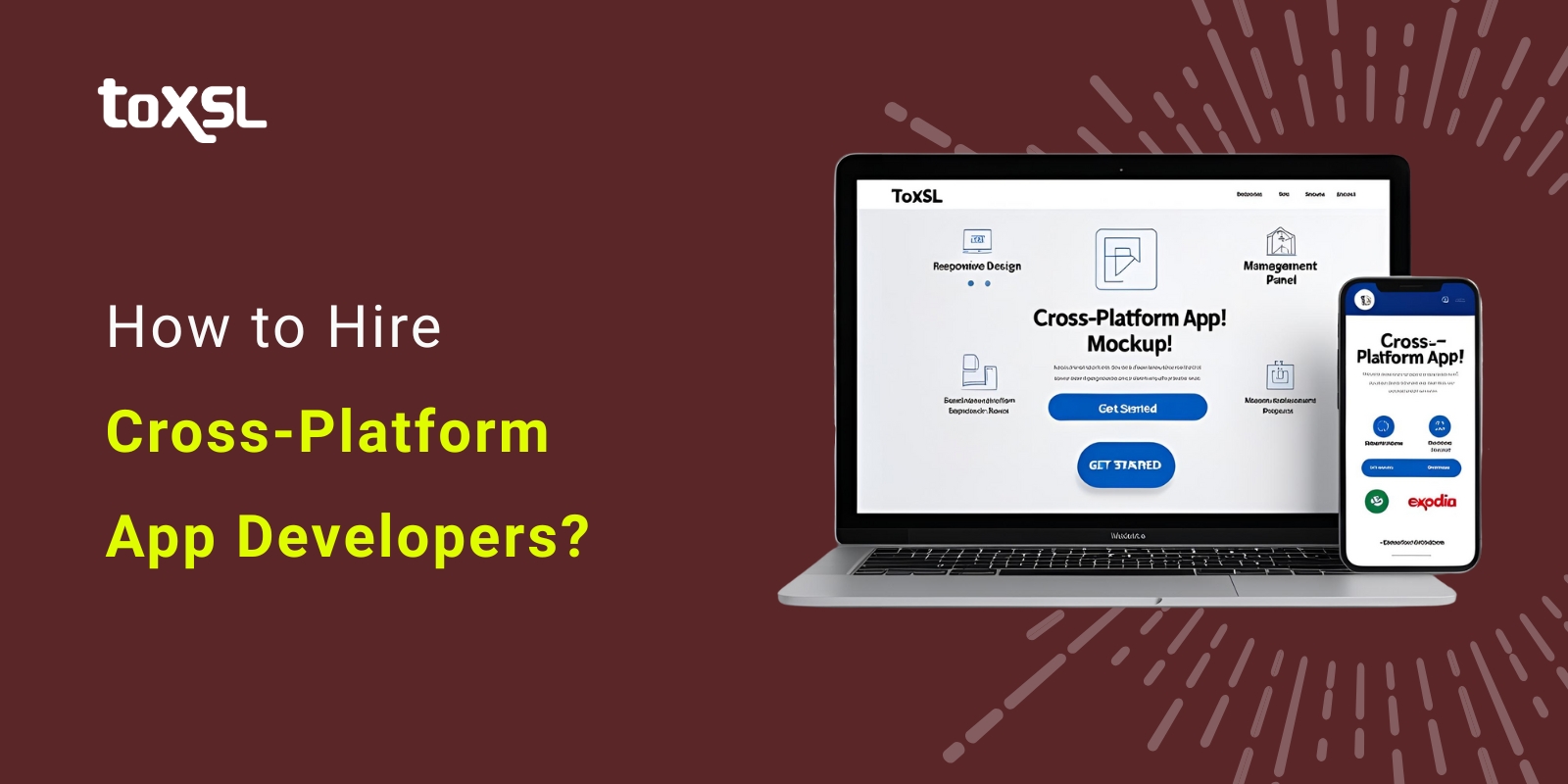- Sep 19, 2025
Share this post on:

With the advent of innovative technologies, the business world is expanding at a rapid pace. Businesses are looking for mobile apps that work seamlessly on various platforms. However, to meet the various requirements of various platforms, developers face numerous challenges. This is where cross-platform development helps developers overcome these challenges.
Cross-platform development means developing mobile apps that run smoothly on multiple platforms, including iOS and Android, using a single codebase. This eliminates the need for a separate codebase for the development of each platform, saving time and cost. Further, frameworks such as React Native, Flutter, and Xamarin facilitate cross-platform development. Before going deeper into the blog, let’s see what stats have to say:
- The cross-platform app development framework is expected to grow from $15.67 billion in 2025 to $42.60 billion by 2034, growing at a CAGR of 11.75%.
- The U.S. cross-platform app development framework market is expected to reach $1,104.7 billion by 2033.
- Approximately one-third of mobile developers use frameworks and technologies for cross-platform development.
Steps to Hire the Best Cross-Platform App Developers for Your Business
Here are a few essential steps that businesses must follow to hire the best cross-platform app developers.
Define Business Scope: The first step is to be clear about your purpose, goals, objectives, and the features that you want to incorporate in your app. Once your objective is clear, and you know your users, sort the list of the top cross-platform app development companies and choose the best framework for your application. If you want your app to run fast, you can select the Flutter framework. For flexibility, you can pick the React Native framework. Finally, ensure to hire the best cross-platform app developers with extensive knowledge of platforms and the technologies needed to build your application.
Define Budget: Developing a cross-platform mobile application has a lot of advantages. Today is the right time to invest in developing applications and making an investment plan. However, it is crucial to evaluate the cost associated with app development, based on its capabilities and complexity. Further, the app budget depends on testing, deployment, and maintenance.
Research and Development: Finding cross-platform app developers is not easy. Ensure to find dedicated cross-platform mobile app developers with a robust portfolio of apps showing their cross-platform applications. Explore various websites and check for authentic reviews and feedback. To contact potential developers from other companies, you can also use tools to enter the website, extract emails, and send a message, making outreach faster and more efficient.
Technical Expertise: Once the research is completed, you can test the expertise of your selected cross-platform developers and verify their capabilities. They must have the required knowledge that can help them maximize the app’s performance. Also, ensure that the selected developers follow the coding standards and security guidelines.
Development process: This is one of the most crucial steps when hiring the right cross-platform app developers. Always discuss the development process with the developers and ensure that the developers follow flexible development methodologies. Ensure to discuss all your requirements with developers before finalizing them.
Pricing Models: Hiring can be a complicated process when it comes to cost. Ensure to learn about the cost estimates of the candidates and evaluate their costs against your budget. Also, before comparing costs, it is important to know the engagement and pricing models for developing apps.
Benefits of Cross-Platform App Development
Cross-platform app development uses a single codebase to develop mobile apps compatible with multiple platforms. Here is why cross-platform app development is the best for businesses:
Cost Savings: Are you looking for the most cost-effective ways of developing mobile apps while saving money? Then you must consider cross-platform app development. One of the biggest benefits that cross-platform apps offer is cost savings. Using cross-platform app development, businesses only need to develop a single code script, saving development costs. Further, if any change is made in the code, it will automatically reflect across all platforms, reducing the need for platform-specific development.
Faster Time-to-market: Cross-platform development is time-saving, as it takes less time to develop and launch an application. Also, businesses are developing only one codebase, removing the need for platform-specific development, helping businesses get their applications to market faster, and allowing them to stay ahead of their competitors.
Wider Reach: Every business wants to go global and increase its reach to a large audience. Cross-platform app development is the solution for that. IT helps businesses increase their user base and drive more revenue.
Consistent User Experience: Cross-platform app development offers a consistent user experience across multiple platforms. This happens because the apps are developing with a single codebase, ensuring that the user interface and features are consistent across all platforms. This can improve the user experience, resulting in higher user engagement and retention.
Easy Maintenance: Cross-platform app development helps businesses maintain their apps easily. As discussed in one of the above points, any changes made to the codebase will reflect across all platforms, eliminating the need for platform-specific maintenance. Cross-platform app development helps businesses save time and money on maintenance and support costs.
Top Cross-Platform App Development Frameworks
Here are the top cross-platform app development frameworks:
Ionic: Ionicenables developers to build mobile apps using familiar web technologies like HTML, CSS, and JavaScript. It includes many mobile-optimized UI components and supports Progressive Web Apps (PWAs). Ionic is great for fast development and teams with web skills. However, performance can lag compared to fully native apps, especially for complex or graphics-heavy applications.
React Native: Developed by Meta, React Native uses JavaScript and React to build apps that render native UI components. It offers near-native performance and a smooth user experience on both iOS and Android. Hot reload speeds up development, and a large community supports a rich ecosystem. Though most features are covered, some complex, platform-specific functions require native coding, so developers may need skills in both native and JavaScript environments.
Flutter: Flutter is Google’s framework using the Dart language. It uses a custom rendering engine to draw UI directly, offering consistent performance and look across platforms. Flutter supports mobile, web, and desktop apps from one codebase. Its hot reload allows fast iteration, and it excels at building rich, visually appealing apps. Dart is less common than JavaScript, but Flutter’s popularity and tools are growing fast. Deep native API integration can be complex, but is improving.
Xamarin: Xamarin targets mobile and desktop platforms with near-native performance and full access to native APIs. Xamarin is ideal for enterprises using Microsoft tools, with strong Visual Studio support. The developer community is smaller, and it requires knowledge of C# and NET.
NativeScript: NativeScript allows developers to build apps with JavaScript or TypeScript that use real native UI components by accessing native APIs directly. It supports frameworks like Angular and Vue. NativeScript offers good performance and a native feel, but has a smaller community and plugin ecosystem. Its learning curve can be steep, especially for new developers.
Node.js: Node.js is not a mobile app framework, but is widely used as a backend for cross-platform apps. It supports building scalable, real-time APIs and services in JavaScript that mobile apps communicate with. Node.js is ideal for apps needing fast, efficient backend solutions shared across multiple clients.
The Future of Cross-Platform App Development
Cross-platform app development is evolving fast, driven by business demand for efficient, cost-effective multi-platform solutions and end-users’ expectations for seamless experiences. Here are a few key trends that will shape the future of Cross-Platform App Development
Increased use of AI and ML integration: Developers are using AI at the app level, requiring frameworks to support such features efficiently.
Advancements in UI frameworks: More expressive, customizable, and adaptive UI frameworks like Flutter are capturing the attention of developers.
Expansion beyond mobile: Cross-platform frameworks will increasingly support desktop and web apps, enabling true multi-platform deployment from a unified codebase.
Growing community and ecosystem: Larger developer communities will lead to richer plugin libraries, faster updates, and more shared knowledge.
Final Words
Hiring cross-platform app developers involves a clear understanding of your project’s goals, choosing the right technology, and looking for candidates with relevant skills and experience. The choice of a cross-platform framework depends on your app’s performance needs, UI requirements, and integration depth.
If you are ready to build or expand a cross-platform app, hire cross-platform app developers from ToXSL Technologies. We have the best cross-platform app developers who are well-versed with the latest trends and technologies. Want to learn more about cross-platform app development? Contact us today.












